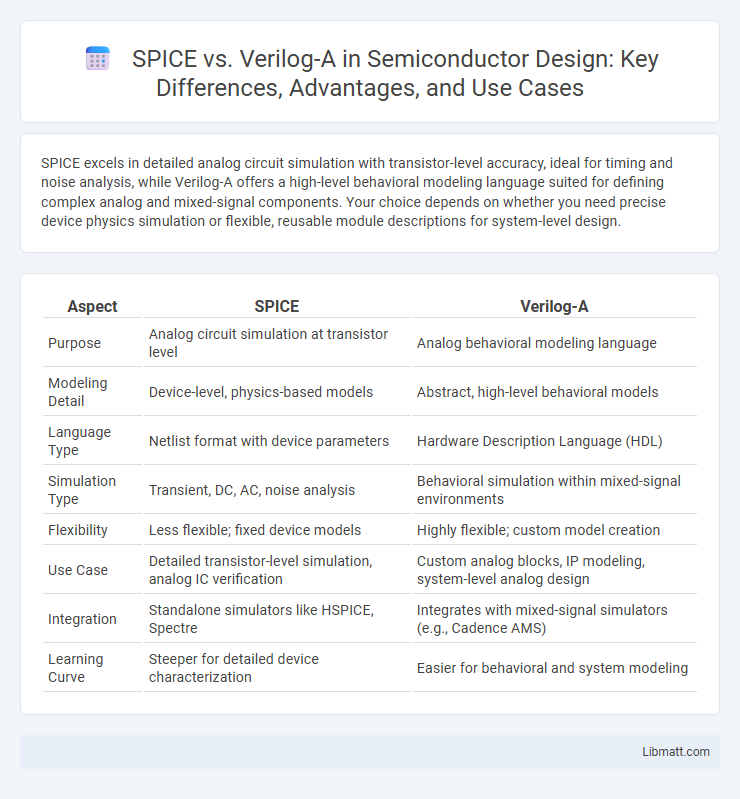SPICE excels in detailed analog circuit simulation with transistor-level accuracy, ideal for timing and noise analysis, while Verilog-A offers a high-level behavioral modeling language suited for defining complex analog and mixed-signal components. Your choice depends on whether you need precise device physics simulation or flexible, reusable module descriptions for system-level design.
Table of Comparison
| Aspect | SPICE | Verilog-A |
|---|---|---|
| Purpose | Analog circuit simulation at transistor level | Analog behavioral modeling language |
| Modeling Detail | Device-level, physics-based models | Abstract, high-level behavioral models |
| Language Type | Netlist format with device parameters | Hardware Description Language (HDL) |
| Simulation Type | Transient, DC, AC, noise analysis | Behavioral simulation within mixed-signal environments |
| Flexibility | Less flexible; fixed device models | Highly flexible; custom model creation |
| Use Case | Detailed transistor-level simulation, analog IC verification | Custom analog blocks, IP modeling, system-level analog design |
| Integration | Standalone simulators like HSPICE, Spectre | Integrates with mixed-signal simulators (e.g., Cadence AMS) |
| Learning Curve | Steeper for detailed device characterization | Easier for behavioral and system modeling |
Introduction to SPICE and Verilog-A
SPICE is a simulation tool used for electronic circuit analysis that models the electrical behavior of components at the transistor level with high accuracy. Verilog-A is a high-level analog hardware description language designed to describe and simulate continuous-time systems and analog circuits with behavioral abstraction. Your choice between SPICE and Verilog-A depends on the need for detailed transistor-level simulation versus higher-level functional modeling in electronic design automation.
Key Differences Between SPICE and Verilog-A
SPICE uses a circuit-level, numerical simulation approach to analyze analog circuits by solving differential equations, while Verilog-A provides a hardware description language framework for modeling analog behavior with higher abstraction. SPICE focuses on detailed transistor-level simulation and accuracy in device-level characteristics, whereas Verilog-A enables efficient behavioral modeling and integration within system-level simulations. The key difference lies in SPICE's accurate, low-level device representation versus Verilog-A's flexible, modular approach to analog and mixed-signal design.
Core Principles of SPICE Simulation
SPICE simulation relies on solving nonlinear differential equations to model analog circuits at the transistor level, providing detailed device behavior through time-domain and frequency-domain analysis. Its core principles include nodal analysis, device equations, and iterative methods like Newton-Raphson for convergence, ensuring accurate transient, DC, and AC simulations. If you require precise electrical characterization, SPICE offers fundamental insights into circuit performance beyond behavioral modeling like Verilog-A.
Fundamentals of Verilog-A Modeling
Verilog-A is a high-level analog behavioral modeling language used to describe electronic components and systems with a focus on continuous-time dynamics, enabling compact and reusable models. Unlike SPICE, which relies on detailed circuit topology and device physics, Verilog-A abstracts circuit behavior using mathematical equations and differential algebraic expressions. Your designs benefit from this flexibility by integrating complex analog behaviors efficiently into mixed-signal simulations, accelerating prototyping and system-level analysis.
Use Cases for SPICE in Circuit Design
SPICE is extensively used for detailed analog circuit simulation, enabling precise analysis of transistor-level behavior in amplifiers, filters, and analog integrated circuits. Its ability to model nonlinear device characteristics and transient responses makes it essential for validating design accuracy and performance under varying operating conditions. Your circuit design benefits from SPICE's robustness when verifying intricate interactions at the component level before moving to higher-level descriptions like Verilog-A.
Applications of Verilog-A in Analog Modeling
Verilog-A excels in analog modeling by enabling designers to create compact, behavioral models for complex analog circuits such as amplifiers, oscillators, and filters. Unlike SPICE, which relies heavily on detailed device-level simulation, Verilog-A allows higher-level abstraction, supporting rapid prototyping and integration of mixed-signal components within system-level simulations. This flexibility makes Verilog-A particularly valuable for custom IC design and parameterized simulations where model reuse and scalability are essential.
Advantages of SPICE Over Verilog-A
SPICE offers highly accurate transistor-level circuit simulation with detailed device models that capture nonlinear behavior, temperature variations, and parasitic effects, making it ideal for precise analog and mixed-signal design verification. It supports extensive device libraries and has been industry-standard for decades, ensuring robust and reliable performance across diverse semiconductor technologies. Its direct circuit netlist approach allows fine-grained control over simulation parameters, yielding consistent, high-fidelity transient, AC, and noise analysis compared to the behavioral abstraction in Verilog-A.
Strengths of Verilog-A Compared to SPICE
Verilog-A offers enhanced behavioral modeling capabilities that enable precise description of analog and mixed-signal circuits beyond the transistor-level detail typical of SPICE. Its hierarchical and modular structure simplifies complex system design and verification, reducing simulation runtimes compared to the often computationally intensive SPICE simulations. Verilog-A's support for event-driven simulation and compatibility with system-level tools provides superior flexibility for designing integrated circuits in advanced technologies.
Integration and Compatibility Considerations
SPICE offers extensive integration with traditional circuit simulators, enabling accurate analog and mixed-signal modeling, while Verilog-A is designed for seamless compatibility with system-level simulation environments like Cadence Spectre and Synopsys HSPICE. Your choice impacts the ease of integrating custom device models within existing electronic design automation (EDA) workflows, as Verilog-A supports behavioral modeling at higher abstraction levels compared to SPICE's transistor-level detail. Compatibility with commonly used simulators and the targeted simulation scope are critical factors to evaluate when deciding between SPICE and Verilog-A.
Choosing Between SPICE and Verilog-A
Choosing between SPICE and Verilog-A depends on the simulation needs and modeling complexity of your electronic design. SPICE excels in detailed circuit-level simulation with precise transistor-level accuracy, while Verilog-A offers higher abstraction for behavioral modeling and easier integration with mixed-signal environments. Your decision should align with whether you require low-level analog precision or faster, more flexible analog-digital co-simulation capabilities.
SPICE vs Verilog-A Infographic

 libmatt.com
libmatt.com